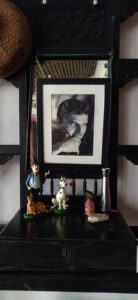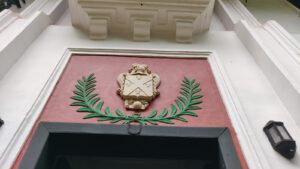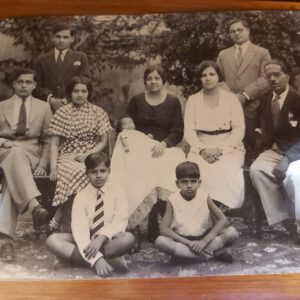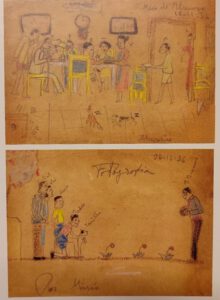
Over the past century and a half, Goa has produced an array of artists.[1] Nearly all of them went to art school in Bombay, joined art movements, and flourished at home or abroad. While recognition of their contribution is long overdue, there is also the curious case of the self-trained artist Mário Carlos do Rosário Brito Miranda (1926-2011), or Mário de Miranda, whom the same fraternity has only grudgingly given credit. He worked in different styles, in different mediums, even across the media; and apparently no frame has been able to encompass his versatility. He was known simply as ‘Mário’, but he was equally Miranda, that is, ‘worthy of admiration’.
Early Life
Mário was born in Damão, to Constâncio do Rosário Miranda[2] and Maria Zulema de Brito.[3] Miranda was a civil administrator in the then Portuguese enclave where he got engaged to pretty Zulema, twenty years his junior. Her family hailed from Assonorá (in north Goa) and was prominent in that town on the Gujarat coast. They married in the groom’s native village, Loutulim (south Goa), in the year 1923, and had their first two children in Damão: Pedro in 1924, and Mário in 1926.

By 1929, the family was back to their splendid manor house that still flaunts a coat-of-arms.[4] Mário wore his heritage lightly but took delight in the old-world ambience marked by wit and humour, music and mirth.[5] He was as much attracted to reading as he was to the piano, sports and pets.[6] But sketching was undoubtedly his first love; so, if not playing records on the wind-up gramophone, he would be doodling Goan celebrities, village bumpkins and animals on the house walls, much to his grandmother’s annoyance. He once said, tongue in cheek: ‘In those days I visualised I would be another Michelangelo… but it didn’t work that way.’[7]

Little Genius
Mário’s mother quick to spot his talent gifted him blank diaries; he feverishly filled them out with bright, breezy colour sketches and a few jottings in Portuguese. They were virtually his confessions; but relatives and friends happily leafed through those pages, which unwittingly froze a microcosm of mid-twentieth-century Goa. In fact, Goan characters so populate his work that one can safely say, ‘Here is Goa’s plenty!’

On closer examination, Mário’s chronicles transcend Goa and mirror universal human nature. The little genius notices everything and everyone, and spares none. The serious and the pompous come very especially under his scanner. According to him, ‘when people take themselves too seriously, they tend to be funny.’[8] While his drawings embody that insightful observation, they don’t merely distort a person’s features; they perceptively bring to light things invisible to the naked eye.[9] Thus, more than just ‘Goa’s plenty’, we may say of Mário’s diaries what Dryden has said of Chaucer’s Canterbury Tales: ‘Here is God’s plenty!’
Mário, perhaps one of the world’s youngest visual diarists, was in his final year at St Joseph’s Boys’ High School, Bangalore, in 1942, when his last sibling, Fátima, was born in that garden city. And while his school buddies lapped up his naughty pencil strokes, his mother dreamt lofty dreams. In the following year, she enrolled him at the J. J. School of Art, Bombay, in preparation for the Beaux-Arts de Paris. But the teenager, feeling trapped rather than freed by formal art education, left the school in a day’s time and joined St Xavier’s College instead. He graduated in English Literature in 1949, and briefly considered joining the Indian Civil Services. Not surprisingly, he later said he was better off as a cartoonist than he would have been as a bureaucrat![10]
Acknowledgements: (1) I am indebted to Fátima Miranda Figueiredo for her knowledge and patience translated into many hours of whatsapp chats about her brother Mário and the family; and to Raul and Rishaad de Miranda for their warm welcome and lively conversation. (2) Banner picture: Portrait Atelier Goa (3) Article first published in Revista da Casa de Goa, Lisbon, Series II, No. 12, Sep-Oct 2021
—————————————————————————————————————————
[1] António Xavier da Trindade (1870-1935), António Piedade da Cruz (1895-1982), Ângelo da Fonseca (1902-1967), Raghuvir Chimulkar (1905-1958), Ângela Trindade (1909-1980), Vasudeo Gaitonde (1924-2011), Francis Newton Souza (1924-2002), Laxman Pai (1926-2021), Vamona Navelcar (1930-), and José Pereira (1931-2015), to name but a few.
2] Constâncio Teodósio do Rosário Miranda (1883-1946) was the son of João Baptista Miranda and Ermelinda Xavier Miranda.
3] Maria Zulema de Brito (1903-1988) was the daughter of Luís Diogo de Brito and Maria Francisca de Melo.
[4] Mário’s great-grandfather Constâncio do Rosário Miranda (Sr.) was granted the coat-of-arms with the title ‘Fidalgo da Casa Real’, for capturing dreaded bandit Custobá Rane, in 1871.
[5] Mário’s father and grandfather were witty gentlemen; his uncle Carlos, later a Supreme Court judge in Portugal, and brother Pedro were artists; and mother Zulema, a pianist. (Fátima Miranda Figueiredo, 23.5.2021)
[6] He was fond of classical literature and music, and played football, volleyball and badminton.
[7] FTF Mario Miranda, 26.4.2003 https://www.youtube.com/watch?v=AvUFUdp20MU
[8] Ibid.; Conversation with Shri Mario Miranda – 2 (Outtakes), https://www.youtube.com/watch?v=wBmMiEqvTy0
[9] FTF Mario Miranda, op. cit.
[10] Doordarshan National, Eminent Cartoonists of India, #04, https://www.youtube.com/watch?v=gkFpyDlQb88
Waiting for Part II Chronicles are so important to keep the memory alive of people who made important contributions to a culture and also for people to know something or more about them, which unfortunately does not happen.
Thank you, Fatima! Hope you enjoy the six-part series.
Very interesting! We are lucky enough to have some of Mario’s books about Goa. Would really like to have met him in person.
Yes, Teresa, you too must have met Mario through the Balbharati… and how I wish I had kept all those school texts!